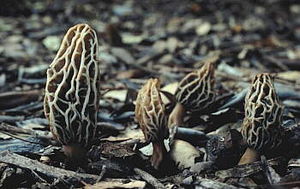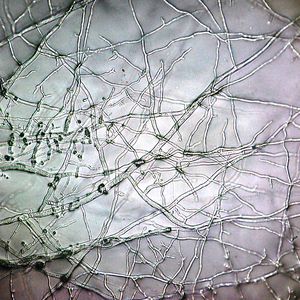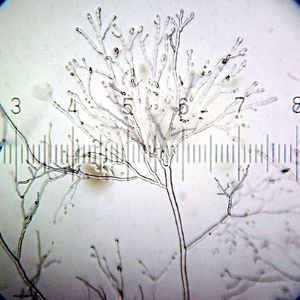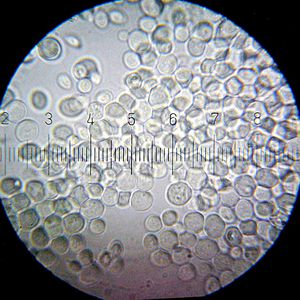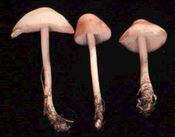DIVERSITY OF ORGANISM
A Short History Of Nearly Everything
History of classification of organism
Carl Linnaeus
Carl Linnaeus, he was a Swedish botanist, physician, and zoologist, who laid the foundations for the modern scheme of binomial nomenclature. He is known as the father of modern taxonomy, and is also considered one of the fathers of modern ecology. Many of his writings were in Latin, and his name is rendered in Latin as Carolus Linnæus.
more info: Click here
carl woese
Having defined Archaea as a new domain, Woese redrew the taxonomic tree. His three-domain system, based on genetic relationships rather than obvious morphologic similarities, divided life into 23 main divisions, incorporated within three domains: Bacteria, Archaea, and Eucarya. Archaea are neither bacteria nor eukaryotes. They can be viewed as prokaryotes that are not bacteria.
More info: Click here
Domain Archaebacteria
Archaebacteria kingdom is a group of bacteria that are anaerobic, as well as aerobic prokaryotes. These bacteria are adapted to living in extreme environmental conditions, like near volcanic activity, deep oceans, etc, and do not need oxygen and light to survive. All living organisms are placed in five kingdom system: plantae animalia, fungi, protist and monera. Not so long ago, before 1977, the archae were considered to be just another group of bacteria. They were thus, placed in Kingdom Plantae. Soon, they were placed under the new kingdom Monera, after the bacteria. Carl Woese and George Fox, were two scientists who proposed in 1977, that archaebacteria should have a different kingdom of their own. By 1990, scientists found out that 16S rRNA and 18S rRNA sequences were totally different in archea from other bacteria. Genome analysis of archae in 2003, confirmed that they are different from bacteria. Thus, finally they were removed from kingdom Monera and the five kingdom of living things was converted into six kingdom system, with the inclusion of the new archaebacteria kingdom.
Domain Bacteria
Bacteria are microscopic (very tiny) organisms that are unicellular (made up of a single cell). Bacterium is the term for a single bacteria.
Evolution of Bacteria: These primitive organisms were among the first to appear on Earth; bacteria evolved roughly 3.5 billion years ago. The oldest-known fossils are those of bacteria-like organisms.
Discovery of Bacteria: Bacteria were unknown to people until the 1600s, when Antony van Leeuwenhoek first observed them in his newly-made microscope.
Cells of Bacteria: The cells of bacteria are different from those of plants and animals in many ways, the most obvious of which is that bacteria lack a nucleus and other membrane-bound organelles (except ribosomes). Unlike animals and plants, bacteria have pili, flagella, and most have a cell capsule.
Bacterial cells include the following:
basal body - A structure that anchors the base of the flagellum and allows it to rotate.
capsule - A layer on the outside of the cell wall. Most but not all bacteria have a capsule.
cell wall - A thin membrane located outside the plasma membrane and within the capsule.
DNA - The genetic material of the bacterium; it is located within the cytoplasm.
cytoplasm - The jellylike material inside the plasma membrane in which the genetic material and ribosomes are located.
flagellum - A long whip-like structure used for locomotion (movement). Some bacteria have more than one flagellum.
pili - (singular is pilus) Hair-like projections that allow bacterial cells to stick to surfaces and transfer DNA to one another.
plasma membrane - A permeable membrane located within the cell wall. It serves many functions for the cell, including energy generation and transport of chemicals .
ribosomes - Small organelles composed of RNA-rich granules that are sites of protein synthesis. The ribosomes are located within the cytoplasm.
capsule - A layer on the outside of the cell wall. Most but not all bacteria have a capsule.
cell wall - A thin membrane located outside the plasma membrane and within the capsule.
DNA - The genetic material of the bacterium; it is located within the cytoplasm.
cytoplasm - The jellylike material inside the plasma membrane in which the genetic material and ribosomes are located.
flagellum - A long whip-like structure used for locomotion (movement). Some bacteria have more than one flagellum.
pili - (singular is pilus) Hair-like projections that allow bacterial cells to stick to surfaces and transfer DNA to one another.
plasma membrane - A permeable membrane located within the cell wall. It serves many functions for the cell, including energy generation and transport of chemicals .
ribosomes - Small organelles composed of RNA-rich granules that are sites of protein synthesis. The ribosomes are located within the cytoplasm.
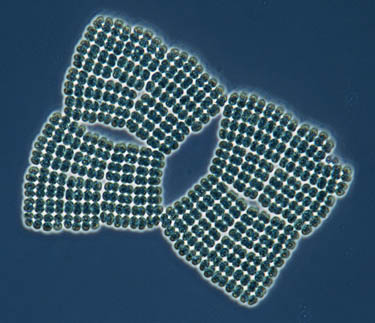
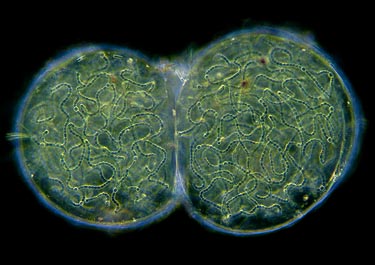
Nostoc is a cyanobacteria that forms large spherical colonies. They are common and can just be seen with the naked eye
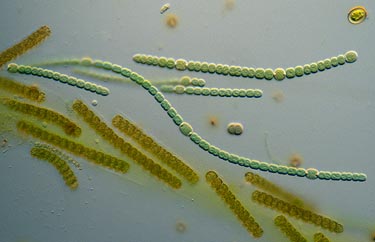
The green Anabaena in this image form a chain of cells. The bigger cells in the chain are able to fixate nitrogen.
Evolution of Bacteria
Domain Eukarya
Eukaryotes: DNA is arranged in chromosomes in a nucleus.
Kingdom Protista.
Protists belong to the Kingdom Protista, which includes mostly unicellular organisms that do not fit into the other kingdoms.
Characteristics of Protists
Kingdom protista can be divide in to 6 groups
Phylum Ciliopora
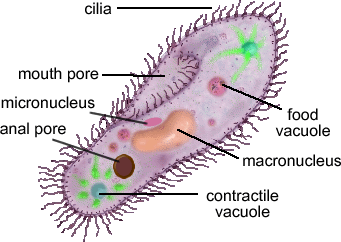
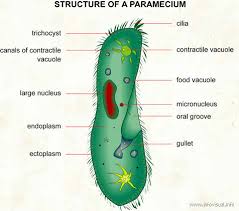
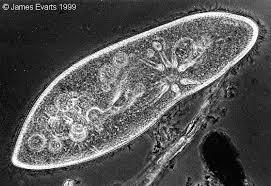
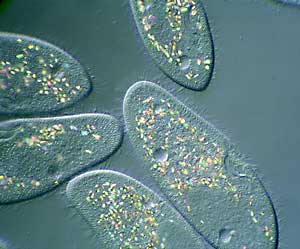
Eukaryotes: DNA is arranged in chromosomes in a nucleus.
The eukaryotes include both single-celled (unicellular) and many-celled (multicellular) organisms.
Cells larger and more complex than cells of Prokaryotes. Contain organelles.
Organelles are structures in cells specialized for particular tasks.
E.g. Mitochondria and Chloroplasts.
Mitochondria and chloroplasts were once free living bacteria. Over time they came to live inside the eukaryotic cells and established a symbiotic relationship.
Now what were once free living organisms have become endosymbionts in Eukaryotic cells.
Symbiosis: very close, mutually dependent relationship between two organisms.
Domain Eukarya 4 kingdoms.
Kingdom Protista.
Kingdom Fungi
Kingdom Plantae
Kingdom Animalia
Kingdom Protista.
Characteristics of Protists
- mostly unicellular, some are multicellular (algae)
- can be heterotrophic or autotrophic
- most live in water (though some live in moist soil or even the human body)
- ALL are eukaryotic (have a nucleus)
- A protist is any organism that is not a plant, animal or fungus
Kingdom protista can be divide in to 6 groups
- Ciliopora
- Rhizopoda
- Chlorophyta
- Rhodophyta
- Chrysophyta
- Phaeophyta
Phylum Ciliopora


- move using cilia
- has two nuclei: macronucleus, micronucleus
- food is gathered through the :mouth pore, moved into a gullet, forms a food vacuole
- anal pore is used for removing waste
- contractile vacuole removes excess water
- exhibits avoidance behavior
- reproduces asexually (binary fission) or sexually (conjugation)
- outer membrane -pellicle- is rigid and paramecia are always the same shape, like a shoe
More info: Click here
Phylum Rhizopoda
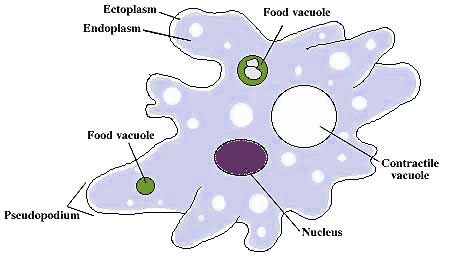
The cell's organelles and cytoplasm are enclosed by a cell membrane; it obtains its food through phagocytosis. This makes amoebae heterotrophs. Amoebae have a single large tubular pseudopod at the anterior end, and several secondary ones branching to the sides. The most famous species, Amoeba proteus, averages about 220-740 μm in length, while in motion. making it a giant among amoeboids. A few amoeboids belonging to different genera can grow larger, however, such as Gromia, Pelomyxa, and Chaos.
Amoebae's most recognizable features include one or more nuclei and a simple contractile vacuole to maintain osmotic equilibrium. Food enveloped by the amoeba is stored and digested in vacuoles. Amoebae, like other unicellular eukaryotic organisms, reproduce asexually via mitosis and cytokinesis, not to be confused with binary fission, which is how prokaryotes (bacteria) reproduce. In cases where the amoeba are forcibly divided, the portion that retains the nucleus will survive and form a new cell and cytoplasm, while the other portion dies. Amoebae also have no definite shape.
more info: Click here
Phylum Chlorophyta
| Chlamydomonas |
| ulva |
| Spirogyra |
Green colour from chlorophyll a and b in the same proportions as the 'higher' plants; beta-carotene (a yellow pigment); and various characteristic xanthophylls (yellowish or brownish pigments). Food reserves are starch, some fats or oils like higher plants. Green algae are thought to have the progenitors of the higher green plants but there is currently some debate on this point.
Green algae may be unicellular (one cell), multicellular (many cells), colonial (living as a loose aggregation of cells) or coenocytic (composed of one large cell without cross-walls; the cell may be uninucleate or multinucleate). They have membrane-bound chloroplasts and nuclei. Most green are aquatic and are found commonly in freshwater (mainly charophytes) and marine habitats (mostly chlorophytes); some are terrestrial, growing on soil, trees, or rocks (mostly trebouxiophytes). Some are symbiotic with fungi giving lichens.
More info: Click here
Phylum Rhodophyta
| Gracilaria |
| Gelidium |
| Laurencia |
The Rhodophyta (red algae) are a distinct eukaryotic lineage characterized by the accessory photosynthetic pigments phycoerythrin, phycocyanin and allophycocyanins arranged in phycobilisomes, and the absence of flagella and centrioles (Woelkerling 1990). This is a large assemblage of between 2500 and 6000 species in about 670 largely marine genera (Woelkerling 1990) that predominate along the coastal and continental shelf areas of tropical, temperate and cold-water regions (Lüning 1990). Red algae are ecologically significant as primary producers, providers of structural habitat for other marine organisms, and their important role in the primary establishment and maintenance of coral reefs. Some red algae are economically important as providers of food and gels. For this reason, extensive farming and natural harvest of red algae occurs in numerous areas of the world
Red algae have a number of general characteristics that in combination distinguish them from other eukaryotic groups:
- absence of flagella and centrioles.
- floridean starch as a storage product and the storage of starch in the cytoplasm.
- phycoerythrin, phycocyanin, and allophycocyanin as accessory pigments.
- unstacked thylakoids in plastids.
- no chloroplast endoplasmic reticulum.
More info: Click here
Phylum chrysophyta
| Pinnularia |
Navicula
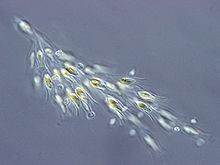
Chrysophytes, or golden algae, are common microscopic chromists in fresh water. Some species are colorless, but the vast majority are photosynthetic. As such, they are particularly important in lakes, where they may be the primary source of food for zooplankton. They are not considered truly autotrophic by some biologists because nearly all chrysophytes become facultatively heterotrophic in the absence of adequate light, or in the presence of plentiful dissolved food. When this occurs, the chrysoplast atrophies and the alga may turn predator, feeding on bacteria or diatoms.
Because Chrysophyta encompasses so many species, there is no common cell structure. Some cell walls are comprised mainly of cellulose, with large amounts of silica, while some are amoeboid with no cell walls. If flagella are present, there may be one or two; if there are two they may or may not be similar. Diatoms are capable of reproducing sexually, but the chrysophytes commonly reproduce through cell division. Members of Chrysophyta tend to be photosynthetic, but some, especially the golden algae, become heterotrophic when there is inadequate light or if dissolved food is plentiful.
More info: Click here
Phylum Phaeophyta
| Turbinaria |
| Sargassum |
| Laminaria |
| Dictyota |
Phaeophyta or brown algae are a group of autotrophic, multicellular organisms, belonging to the class Phaeophyceae of the division Chromophyta. They contain the xanthophyll pigment - fucoxanthin, in addition to chlorophyll a and c. Hence, the members of phaeophyta exhibit a characteristic greenish-brown color. The brown colored pigment is very important for the adaptation of phaeophyta in deep seas and oceans. Phaeophyta are commonly adapted to marine environment, only a few phaeophyta are freshwater species. In fact, majority of phaeophyta are predominant in the temperate zones of Northern Hemisphere, whereas some species are found in warm tropical waters. As of now, about 1500-2000 species of brown algae are identified throughout the world.
Phaeophyta are the most complex forms of algae. The cell walls are composed of cellulose and alginic acid (a complex polysaccharide). Unlike green algae or Cholorophyta, they lack true starch. The food reserves contain sugar, higher alcohol and other complex forms of polysaccharides. The members of phaeophyta belonging to Laminarales are called kelps.
Kelps are the only algae with a significant internal tissue differentiation. Though true conductive tissues like xylem and phloem are absent, kelps show some sort of conductive tissues. Similar to other evolved algal species, reproduction of this algae takes place by both sexual and asexual means. Higher phaeophyta have life cycle consisting of both haploid and diploid stages, referred to as an alternation of generation. The thallus representing haploid stage and diploid stage may be similar (isomorphic) or different (hreteromorphic).
- Phaeophyta evolved about 150-200 million years.
- They are either microscopic or macroscopic.
- Life cycle of phaeophyta differs from one member to another.
- In higher members of phaeophyta, life cycle consists of alternation of haploid stage and diploid stage.
- They can adapt to a wide marine environment; tidal, intertidal and deep zones.
- Some members of phaeophyta have adaptive bladders, meant for floating photosynthetic parts on or near the water surface for harvesting light.
- Largest phaeophyta forms, for example, a giant kelp can reach to about 70 meters in length.
- They often cause nuisance to aquarium environment by developing brown patches on any exposed surfaces such as glass, rocks or gravel.
Commercially exploited phaeophyta include those belong to the orders, Laminarales and Fucales. Previously, marine seaweeds of phaeophyta are used for the extraction of iodine and potash. In recent times, phaeophyta are extensively exploited for the extraction of alginic acid. This alginic acid is used for deriving alginate, a major colloidal gel used as a stabilizer, emulsifier or binder in many industrial applications.
More info: Click here
Kingdom Fungi
The Kingdom Fungi includes some of the most important organisms, both in terms of their ecological and economic roles. By breaking down dead organic material, they continue the cycle of nutrients through ecosystems. In addition, most vascular plants could not grow without the symbiotic fungi, or mycorrhizae, that inhabit their roots and supply essential nutrients. Other fungi provide numerous drugs (such as penicillin and other antibiotics), foods like mushrooms, truffles and morels, and the bubbles in bread, champagne, and beer.
Fungi also cause a number of plant and animal diseases: in humans, ringworm, athlete's foot, and several more serious diseases are caused by fungi. Because fungi are more chemically and genetically similar to animals than other organisms, this makes fungal diseases very difficult to treat. Plant diseases caused by fungi include rusts, smuts, and leaf, root, and stem rots, and may cause severe damage to crops. However, a number of fungi, in particular the yeasts, are important "model organisms" for studying problems in genetics and molecular biology.
mainly we can divide Kingdom Fungi to 4 different groups
- Ctridiomycota
- Zygomycota
- Asomycota
- Basidyomycota
Ctridiomycota
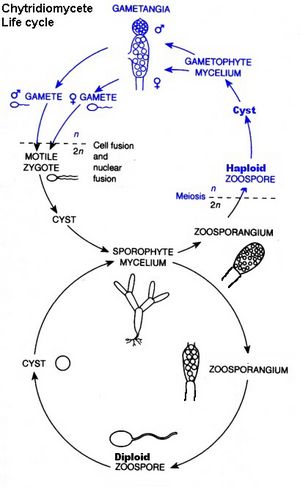 |
| Diagram of life cycle |
| Allomyces |
| Chytridium |
Chytridiomycota are the smallest and simplest fungi. They emerged soon after the Precambrian period, and are ancestors to all Fungi. The first Chitridiomycota were found in northern Russia. There are three orders within Chytridiomycota: Chytridiales, Blastocadiales, and Monoblepharidales.
There are many different species within the classification of Chytridiomycota, and all have different genomes. For example, the species , there are eight mitochondrially-encoded tRNAs, and it is believed that they have at least one base pair mismatch at the first three positions of their aminoacyl acceptor stems. Bullerwell and Gray (2005) have developed a method of tRNA editing using the mitochondiral extract of S. punctatus. 5' tRNA editing occurs in the mitochondria of this species, as well as in the chytridiomycete order Monoblepharidales. However, it does not occur in Rhizophydium brooksianum. Laforest et. al. (2004) believe that 5' tRNA edition evolved twice independently within Chytridiomycota. The genome structure of Batrachochytrium dendrobatidis shows only five variable nucleotide positions, meaning it has a low level of genetic variation. Other characteristics of the B. dendrobatidis genome include nearly fixed heterozygous genotypes as well as chromosome lengtgh polymorphisms. The genes that encode alpha- and beta-tubulins are useful for encoding fungal phylogeny. Corradi et. al. (2004) studied the genetic similarities between members of Chrytidiomycota and arbuscular mycorrhizal fungi (AMF). They found large evolutionary differences at the amino-acid level, but at the mitochondiral level, differences were significantly smaller. Anaerobic chytridiomycetes contain an enzyme called pyruvate formate lyase, which is essential for f.ermentative formate production. This enzyme exists in the genetic structure of only one other eukaryotic lineage, chlorophytes.
Chytridiomycota have unicellular or mycelial thalli. Cell walls are made of chitin, although one group has walls made of cellulose. Cell growth can be unicellular, or it can occur in the multicellular mycelium of aseptate hyphae. The thallus is typcially unicellular; it may also have limited hyphal growth. It is not considered mycelial. Hyphal cells are coenocytic, although this is not the case where there are reproductive structures. The ultrastructure of the zoospore is a definitve characteristic of Chytridiomycota. In the structure, ribosomes are aggregated around a nucule that is not enclosed in a nuclear cap. A nuclear cap is an extension of the nuclear membrane. Chytridiomycota have one or two flagella.
Zygomycota
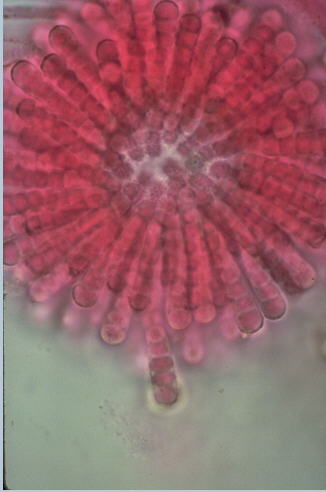 |
| Syncephalastrum racemosum |
| Mucor |
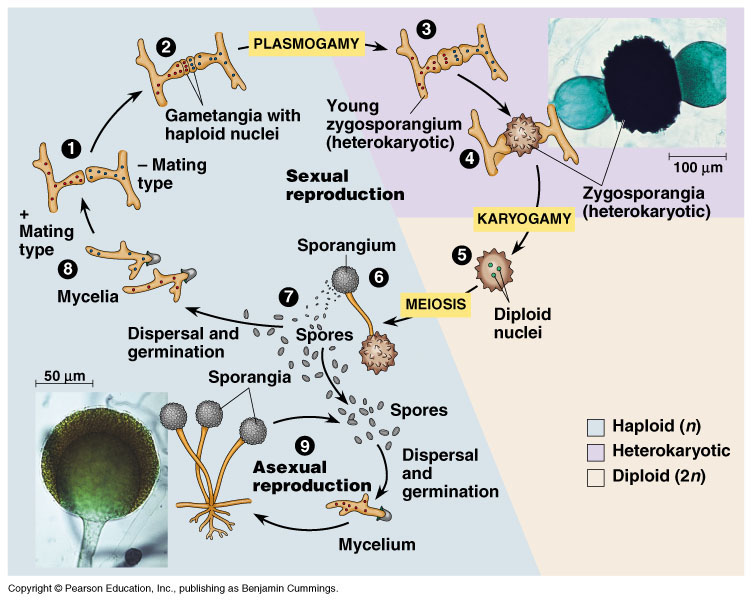 | |||||||||||||||||||||||||||||||||||||
| Zygomycota life cycle
Cell walls are composed of chitin-chitosan. The mature zygospore has thick walls. Zygomycota also have coenocytic mycelium.
They normally grow as mycellia or as filaments of long cells. Hyphae typically lack cross walls or septa, and therefore are coeonocytic. It is believed that zygomycota have zygotic or haplontic life cycles. Zygomycota are able to reproduce both sexually and asexually. In fact, sexual reproduction via zygospores following gametangial fusion is a definitive characteristic of Zygomycota. Sexual reproduction is haploid-dominant, while asexual reproduction makes use of aplanospores. In Zygomycota, sexual reproduction is the fusion of undifferentiated isogametangia or anisogametangia. Mating strains (progametangia) grow toward each other and induce the hormone trisporic acid to intiate sexual development. This fusion produces a zygote, which develops into a zygospore. The way Zygomycota reproduce asexually is also distinctive. With asexual reproduction, asexual spores called sporangiospores are produced in sporangia. Typically, three sporangia are produced, but there are variations within asexual reproduction. Nuclei move to the ends of the progametangia to form septa. Plasmogamy and karyogamy follow the fusion of the progametangia. Sexual reproduction ends with the formation of the zygospore. Because of the Zgomycota life cycle, only the diploid phase takes place in the zygospore. Zygospores must undergo a dormant period before beginning the reproductive cycle again.
More info: Click here
Ascomycota
Diversity of mosses has been classified in approximately 10,000 species, 700 genera, and about 110-120 families. This places the mosses as the third most diverse group of land plants, only after the angiosperms and ferns. Mosses are small plants requiring stereoscopes and compound microscopes for routine examination. The conspicuous green leafy shoots are the gametophytes, haploid organisms, on which the diploid embryo develops into a mature sporophyte. The sporophyte is chlorophyllose and photosynthetic only in early stages of development, and it is mostly dependent on the gametophyte. Moss colonies are a very important element in many ecosystems, from the tundra to the tropical rain forest, reducing soil erosion, capturing water and nutrients, providing shelter for microfauna, and nurseries for seedlings in succession or regeneration processes.
As a lineage, mosses are a historically crucial group in the understanding of the transition to life on land. The green leafy shoots (gametophytes) retain some features of the green algal ancestors (chlorophylls a and b, starch, sperm with two forward undulipodia), but the needle-like shoots that produce the spores (sporophytes) display key innovations for the life outside water, such as stomates, a simple strand of conductive cells [in an unbranched sporophyte], and airborne spores produced in a single apical capsule (sporangium). This is the simplest structural level among all land plants. The next organizational level is found in two fossil groups: Horneophythopsida and Aglaophyton (Rhynia) major, where the sporophyte is branched and produces several sporangia. The sporophyte shows the most complex structural organization in the tracheophytes.Diversity of mosses has been classified in approximately 10,000 species, 700 genera, and about 110-120 families. This places the mosses as the third most diverse group of land plants, only after the angiosperms and ferns. Mosses are small plants requiring stereoscopes and compound microscopes for routine examination. The conspicuous green leafy shoots are the gametophytes, haploid organisms, on which the diploid embryo develops into a mature sporophyte (Figure 1). The sporophyte is chlorophyllose and photosynthetic only in early stages of development, and it is mostly dependent on the gametophyte. Moss colonies are a very important element in many ecosystems, from the tundra to the tropical rain forest, reducing soil erosion, capturing water and nutrients, providing shelter for microfauna, and nurseries for seedlings in succession or regeneration processes.
More info: Click here
Lycophyta
More info: Click here
Pterophyta
More info: Click here
Cycadophyta
The cycads are known to be an extremely ancient group, and are now recognised as the sister group to all other living seed plants. Fossil cycads are known from the Lower Permian, of China, 270-280 million years ago, and the group is thought to have arisen from within the ancient seed ferns, of the later Palaeozoic, era, which ended 250 million years ago. The cycads radiated and spread widely in the Permian and early Mesozoic, and have continued as a separate lineage since that time. The Mesozoic era, and especially the Jurassic period of this era, is often referred to as the 'Age of Cycads'. During this time, cycad-like plants, along with the conifers and Ginkgoales, dominated the vegetation of the world. Fossil cycads are known from Mesozoic deposits of every continent and every latitude, from Siberia to the Antarctic. This perception of the cycads as dominant plants of the Mesozoic Era is, however, somewhat misplaced, resulting from past confusion of the cycads and a quite separate, now extinct, group known variously as the Cycadeoids or the Bennettitales.
More info: Clcik here
Coniferophyta
This is a conspicuous group of woody plants commonly known as the "conifers". The members of this group produce ovules that mature into seeds. These ovules and seeds are found on the upper surfaces of scale structures which often are clustered into "cones". The Coniferophytes are considered "gymnosperms" (as are the Ginkgophytes) due to the fact that the seeds are exposed in the cone scales rather than being enclosed within an ovary as in the Angiosperms (flowering plants). All conifers are woody plants and many form very large trees. Most conifers are evergreen, however, Metasequoia glyptostroboides (see below) is one locally cultivated, non-native example of a conifer that is deciduous (it sheds all of its leaves and grows a new set each year).
More info: Click here
Anthophyta

More info: Clcik here
| |||||||||||||||||||||||||||||||||||||



